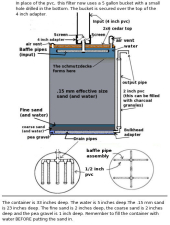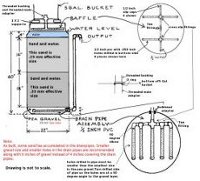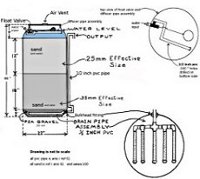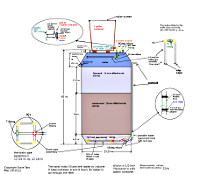
Rainwater harvesting with Sustainable
technology:
A look at the design, construction and operation of a small scale slow sand water filter. (Building a small slow sand water filter for individual use)
A look at the design, construction and operation of a small scale slow sand water filter. (Building a small slow sand water filter for individual use)
|
Please help support
this site by purchasing a summary of our research which includes
drawings, pictures and construction details to build filters.
This page on our blog has the info. $7.50 Thank
you!!
|
> Introduction
Water Test Results
Water color improvement
Slow sand filter FAQ
Literature Cited
Contact the author
Terms of Use / Copyright information
External links:
Slow Sand filter Blog
Roof water harvesting summary
First posting 2008-09-17
Page Updated 2022-01-30
Website Updated 2022-01-30
Water Test Results
Water color improvement
Slow sand filter FAQ
Literature Cited
Contact the author
Terms of Use / Copyright information
External links:
Slow Sand filter Blog
Roof water harvesting summary
First posting 2008-09-17
Page Updated 2022-01-30
Website Updated 2022-01-30
Introduction
The slow sand filter projects documented on this website have taken place in the pacific northwest area of Washington state, USA. The first filter project (filter one) was started in early 2007. All of the projects are ongoing and will continue as long as the author is able. The water quality tests that have been done by epa certified testing laboratories are noted as such. The preliminary field tests are done onsite and are also noted as such. The researcher has a four year degree from the University of Washington (class of 2006) in environmental studies plus 35 years of experience in non-academic work. Chemicals used for drinking water treatment such as chlorine, or ozone that produce toxic cancer causing byproducts are not used in these filters. The longest running slow sand water filter project this site documents has been ongoing for ten years (it was started in the summer of 2007). It will continue as long as possible.
Keep in mind that "Backwashing" a biological sand filter will destroy it.; and that a biological sand filter is constantly full of water up to and covering the top surface of the sand inside by at least 1 inch or more - the sand must not be exposed to air.
Know that the content of this site will change considerably as this study continues.
Rain barrels are now legal in Washington state! For over 90 years it has been illegal to catch rainwater in Washington state.note 2 As of October 9 2009, catching roof water is no longer a crime! The department of Ecology in Washington state (the D.O.E.) has finally clarified the law so as to allow individuals to catch rainwater for their own use. (from this preceding link, click on the links at the D.O.E. site on the upper right hand side of their page that say "new" highlighted in yellow.)
So far work has been done on Five separate small slow sand filters:
-10-18
The slow sand filter projects documented on this website have taken place in the pacific northwest area of Washington state, USA. The first filter project (filter one) was started in early 2007. All of the projects are ongoing and will continue as long as the author is able. The water quality tests that have been done by epa certified testing laboratories are noted as such. The preliminary field tests are done onsite and are also noted as such. The researcher has a four year degree from the University of Washington (class of 2006) in environmental studies plus 35 years of experience in non-academic work. Chemicals used for drinking water treatment such as chlorine, or ozone that produce toxic cancer causing byproducts are not used in these filters. The longest running slow sand water filter project this site documents has been ongoing for ten years (it was started in the summer of 2007). It will continue as long as possible.
Keep in mind that "Backwashing" a biological sand filter will destroy it.; and that a biological sand filter is constantly full of water up to and covering the top surface of the sand inside by at least 1 inch or more - the sand must not be exposed to air.
Know that the content of this site will change considerably as this study continues.
Rain barrels are now legal in Washington state! For over 90 years it has been illegal to catch rainwater in Washington state.note 2 As of October 9 2009, catching roof water is no longer a crime! The department of Ecology in Washington state (the D.O.E.) has finally clarified the law so as to allow individuals to catch rainwater for their own use. (from this preceding link, click on the links at the D.O.E. site on the upper right hand side of their page that say "new" highlighted in yellow.)
So far work has been done on Five separate small slow sand filters:
-10-18
 Filter one (external link) |
 Filter two float valve installed 2011-04-07 |
 Filter three |
|
 filter 4 |
 filter 5 |
Average flow rates:
filter 1: 12 liters per hour
filter 2: 35 liters per hour
filter 3: 36 liters per hour
filter 4: 45 liters per hour
filter 5: 12 liters per hour
Originally, flow measurements were taken by recording the number of minutes required to fill a 12 litre container.
Most recently (2010-12-19) we are using a 4 litre container, as it is more indicative of instantaneous flow volume when measuring the flow from a filter that is not fed by a steady flow of water. The 4 litre container was tested against the 12 liter container using filter 2 which has a steady flow (its input is controlled by a float valve and pressurized water). The 4 litre container was found to result in flow measurement precision and accuracy equal to the 12 litre container when the flow volume totals were averaged.
1 cubic meter = 1000 litres 1 litre = .001 cubic meter
We use flow rate per unit area per unit of time because we are interested in quantifying how fast the water flows past a given level in a given area. Simply measuring liters per hour does not give the full story. For example; 20 liters per hour from a 25 cm diameter container does not allow the same sand particle contact time as 20 liters per hour from a 75 cm diameter container, and sand particle contact time is critical for allowing maximum purification.
flow rate should be between .1 and .4 meters per hour (ideally between .1 and .3 meters per hour for the best results
This is how to figure the flow rate by just measuring how many litres flow per hour:
flow rate in meters per 1 hour = [(liters per 1hr)÷1000]÷(area of sand bed surface in square meters)
Explanation:
Here we will use X to mean multiply; and / to mean "per" as in per hour; and the ÷ to mean divide
L means litres and m means meters
In this formula, a cubic meter is represented by meters cubed or just: m3
(in other words meters X meters X meters or think of length X width X height the way we find volume)
And the area of the sand surface is represented by meters squared or just m2
meters X meters (length X width the way we find area)
Now, know that 1 cubic meter = 1000 Litres, or more simply: m3 = 1000L
Divide litres by 1000 to get cubic meters; or multiply litres by .001 to get cubic meters
If m3 = 1000L, then cubic meters/hour = Litres/hour ÷1000
(the per hour thing is there because we need to have a concept of motion over a time period
since it is 1 hour it does not change the result division by 1 or multiplication by 1 is identity)
or more simply: m3 per hour = (L per hour)÷1000
Now; m/hr = [(L/1hr)÷1000]÷m2
or just m/1hr = (m3/1hr)÷m2 (the m3 and m2 cancel out into just m so we end up with m/1hr)
Now, the above translated into language:
flow rate in meters per hour = volume in cubic meters per hour ÷ sand surface area in square meters
and finally back to where we started:
flow rate in meters per 1 hour = [(liters per 1hr)÷1000]÷(area of sand bed surface in square meters)
A simplified version of the above is:
For the shorter large barrel with a sand surface area of .26791 sq meters (23 inch diameter):
flow rate in meters per 1 hour = (53.75) ÷ (time in seconds to fill a 4 litre container)
For the taller smaller diameter barrel with a sand surface area of .2452 sq meters (22 inch diameter):
flow rate in meters per 1 hour = (58.73) ÷ (time in seconds to fill a 4 litre container)
Page design by Perpetual PC's
This work is licensed under
Creative Commons Attribution Share Alike 3.0.
terms of use